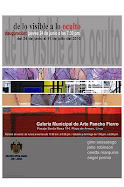 My general proposal is to create an object that encourages people to get closer to each other, to look carefully at others.
My general proposal is to create an object that encourages people to get closer to each other, to look carefully at others.At the International Glass Centre of Dudley College, I came back to study what does space mean. I had studied it in Lima, where I usually live, as part of my art studies. But, suddenly, here in the UK, a completely different country, I found myself struggling to build a space for me within it in order to be able to be me, to exist…
At the beginning I felt myself completely lost, looking for familiar landscape, names, faces, traditions, language, values… I was trying to recognize myself in other faces. As time was passing I discovered I was not the only one feeling that way. Most of us, the students at the International Glass Centre, were feeling outsiders. One can be an outsider even in his/her own country.
Culture is not about nationality, nor races neither material objects. It is about “shared meanings”. It is about feelings, attitudes, attachments and emotions as well as ideas and concepts. Stuart Hall, from the Open University, tells us that culture is not much a set of things, but as a process, a set of practices. It has to do with the exchange of meaning between the members of a society.
Meaning is what gives us a sense of identity about who we are and where or what group we “belong” to. It is what we understand and feel about things and it is not set forever. Meaning is in permanent change and it is constantly produced and exchanged in every personal and social interaction in which we take part. We use signs and symbols to represent meaning. When you are not able to “read” these signs you become an outsider inside the group, even if you have been born in the same country, in the same house…
At the Centre we were divided into groups to work. Our team was and is one of the most diverse. Ireland, France, South Africa, The Netherlands, United Kingdom (with four counties) and Peru are represented within it. We are nine men and women of different ages and from different backgrounds. But this, instead of a weakness, was our strength.
As time started to pass, in order to make our work, we had to learn about each other. We had to get closer to realize what were our differences and what our similarities. I think we learned more from the first ones. We learned about the “other” but, at the same time, we learn a lot more about ourselves.
I understand diversity as a medium that helps us to find our own identity. It challenges ourselves and helps us to discover new aspects of who we are.
My objective is to create a phenomenological space to encourage people to find similarities and differences in order to see themselves, to know who they are.
I chose to build a cube, using the square shape as a base. Square is the Pacha in the Andean Culture. It shows the double logic underneath its cosmological vision. It represents the space and the order at the same time. I use the image of some of the members of my group as well as of my housemates. I also used the images of two members of the staff of the Centre, Kevin and Jim, who help us in this process with their silent but invaluable presence.
I worked these images in Photoshop in order to distort them. The faces are not important. The idea is that as soon you decide to get closer to “other” you will find people who will go along with you. In their inner mirror faces of the cube I wrote Emergency Room for a Cultural Shock to give an idea of what it is built for. On the outer faces of the mirrors sides, I used images of my family and my country, in order to show how this process is linked with who I am. I used glass as a medium in order to show the fragility of the process. It is so easy to give up…
This work was joint overall winner of “Diversity in College” Contest at Dudley College in UK, March 2005









No hay comentarios:
Publicar un comentario